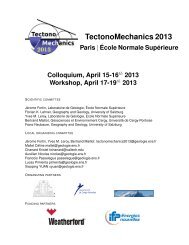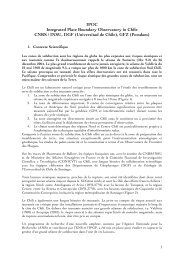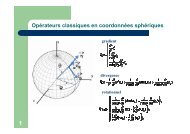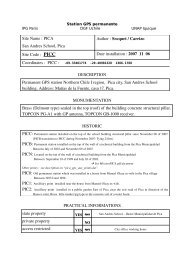MICROBLOCK ROTATIONS IN SULAWESI, INDONESIA more fully un<strong>de</strong>rstand this process, a more precise <strong>de</strong>scription of these microblocks’ motions and a better un<strong>de</strong>rstanding of the main active structures of the area are necessary. The purpose of this paper study is to <strong>de</strong>fine the <strong>de</strong>formation of the Sulawesi area utilizing geo<strong>de</strong>tic and seismological data. Using a <strong>de</strong>ca<strong>de</strong> of GPS measurements, we estimate the kinematics and likely boundaries of the micro blocks. We also examine the active faults of Sulawesi (e.g. Palu-Koro and Gorontalo strike-slip faults) in <strong>de</strong>tail to quantify their interseismic behaviour and assess their contributions to seismic hazards. Toward these ends, we mo<strong>de</strong>l our GPS velocities and earthquake slip vector azimuths with a combination of rigid block rotations [Morgan 1968; Peltzer and Saucier, 1996] and elastic <strong>de</strong>formation due to locking on the faults separating the blocks [Okada, 1985, 1992; Savage, 1983; Savage and Burford, 1973]. This simultaneous inversion results in Euler vectors <strong>de</strong>scribing rigid block rotation in addition to <strong>de</strong>gree of coupling on the faults. Geodynamic setting Present-day kinematics According to the Nuvel-1A plate motion mo<strong>de</strong>l, the triple junction of South-East Asia is a T-T-F (trenchtrench-fault) type between the Eurasian (or Sunda), Australian and Philippine Plates [DeMets, et al., 1990; 1994] (Figure 1). The Australian and Philippine Plates subduct beneath the Eurasia (or Sunda) Plate at rates of 75 mm/yr and 90 mm/yr respectively. The E-W trending Australia – Philippine Sea / Pacific boundary zone that extends from eastern Indonesia through New Guinea accommodates the relative plate motion by transpressive faulting and tectonic block rotation [Tregoning et al., 1998, 1999, 2000; Stevens et al., 2002; Wallace, et al., 2004]. GPS measurement in Indonesia have helped consi<strong>de</strong>rably to refine the plate kinematics of South-East Asia [Punto<strong>de</strong>wo et al., 1994; Tregoning et al., 1994; Genrich et al., 1996, 2000; Prawirodirdjo et al., 1997, 2000; Michel et al., 2001; Bock et al., 2003]. In particular, GPS velocities revealed that the Eurasian Plate does not inclu<strong>de</strong> South-East Asia, but instead the separate Sunda plate moves at about 10 mm/yr eastward relative to Eurasia [Chamot-Rooke and Le Pichon, 1999; Michel, et al., 2001; Simons, et al., 1999]. Studies based on <strong>de</strong>nser GPS arrays in Sulawesi reveal even finer <strong>de</strong>tail on block-like motions, for example rapid clockwise rotation of the northern part of the Sulawesi Island, named the Sula Block, with respect to the Sunda Block [Walpersdorf et al., 1998a, 1998b; Stevens et al., 1999]. The latest study, based on 100+ sites in SE Asia, shows that <strong>de</strong>formation affects both the East Borneo and Sulawesi areas, while southern Sulawesi in particular, also moves in<strong>de</strong>pen<strong>de</strong>ntly of the Sunda Plate [Simons et al, sub]. These studies show that Sulawesi is clearly not a 2 Figure 1: Structural map of the Sunda – Australia – Philippine - Pacific Plates junction area. Arrows <strong>de</strong>pict the far field velocities of the plates with respect to Eurasia. Fault traces adapted from Hamilton (1979). part of the Sunda plate, but instead is itself broken into multiple micro-blocks accommodating complex <strong>de</strong>formation. Regional active structures The active structures of the Sulawesi area show complex patterns of faulting [Hall, 2002; Hall and Wilson, 2000]. The Sunda plate is boun<strong>de</strong>d to the south by the Sunda-Banda arc which is associated with the northward subduction of the Australian Plate. Subduction of the Australian Plate at the Java Trench evolves into collision with Australia along the Timor Trough south of Sulawesi [McCaffrey and Abers, 1991]. Highly oblique convergence (~110 mm/yr) between the Pacific (or Caroline after [Weissel and An<strong>de</strong>rson, 1978]) and the Australian Plates is accommodated in western New Guinea where shortening and left-lateral shear are distributed among several tectonic boundaries [McCaffrey and Abers, 1991; Punto<strong>de</strong>wo, et al., 1994; Stevens et al., 2002]. Faults in New Guinea continue to the west to the Seram Trough and to the Sula-Sorong Fault that continues into Sulawesi. In the Philippines, the oblique convergence between the Sunda and Philippine Plates is accommodated by partitioning of the slip between the Philippine trench and the Philippine fault [Aurelio, 2000; Fitch, 1972]. The Manillia-Philippine trench system un<strong>de</strong>rgoes trenchnormal convergence [Rangin, et al., 1999] while leftlateral strike-slip is taken up on the Philippine Fault [Barrier, et al., 1991]. The central part of the South-East Asia triple junction coinci<strong>de</strong>s with Sulawesi (Figure 2). The northern part of the island, is colliding with the Sunda Plate [Rangin, 1989; Silver, et al., 1983; Silver, et al., 1983]. This relative motion is accommodated by left-lateral strike-slip motion along the Matano / Lawanopo Fault (the western
MICROBLOCK ROTATIONS IN SULAWESI, INDONESIA Figure 2: GPS velocities of Sulawesi and surrounding sites with respect to the Sunda Plate. Grey arrows belong to the Makassar Block, black ones to the northern half of Sulawesi and white ones to non-Sulawesi sites (99% confi<strong>de</strong>nce ellipses). Numbers near the tips of the vectors give the rates in mm/yr. The main tectonic structures of the area are shown as well. continuation of the Sula-Sorong Fault [Hinschberger, et al., 2000]) which continues to the Palu–Koro Fault in the north, which then connects to the Minahassa trench where subduction occurs (Figure 2). The Gorontalo strike-slip fault cuts the northern arm of Sulawesi and may connect to the Minahassa trench. At the Eastern termination of the Minahassa Trench, the Sangihe double subduction zone accommodates convergence between the 3 Philippine Plate and Sulawesi across the Molucca Sea (Figure 2). The main active structure in Sulawesi is the Palu-Koro fault and its southeast continuation to the Matano fault and/or Lawanopo fault. The Palu-Koro fault bisects the island: the Makassar block on the southwest and the North Sula block on the northeast. GPS shows that the total motion across the fault is around 4 cm/yr. If this slip
- Page 1 and 2:
Thèse en vue d'obtenir le diplôme
- Page 3 and 4:
Résumé Depuis une quinzaine d'ann
- Page 5 and 6:
écepteur GPS devient un sismograph
- Page 7 and 8:
au diamètre de l'enveloppe du nuag
- Page 9 and 10:
Figure 3. répétabilités (c'est
- Page 11 and 12:
Les domaines d’application a) con
- Page 13 and 14:
cours desquels la faille va moins v
- Page 15 and 16:
- Y a-t-il un régime permanent ? o
- Page 17 and 18:
temps en temps (pour refaire régul
- Page 19 and 20:
Conclusion Pour tous les objectifs
- Page 21 and 22:
Les vitesses calculées sur la pér
- Page 23 and 24:
A cause des progrès des mesures en
- Page 25 and 26:
Il est probable que l'on va bientô
- Page 27 and 28:
attendre longtemps pour que ce mouv
- Page 29 and 30:
Les réseaux GPS en Birmanie et les
- Page 31 and 32:
Chargement élastique sur la faille
- Page 33 and 34:
à l'échelle de toute la Birmanie
- Page 35 and 36:
vitesses observées et modélisées
- Page 37 and 38:
Le séisme de Sumatra (Banda Aceh)
- Page 39 and 40:
la composante Nord-Sud du mouvement
- Page 41 and 42:
Propagation de la rupture et des on
- Page 43 and 44:
La subduction Chilienne Contexte :
- Page 45 and 46:
La modélisation (dislocation en "b
- Page 47 and 48:
Mesures dans la lacune de Coquimbo
- Page 49 and 50:
Là encore, nous avons montré qu
- Page 51 and 52:
Erosion: GPS cinématique sur un pl
- Page 53 and 54:
Christophe VIGNY Né le 02 Mars 196
- Page 55 and 56:
d) j’ai été pendant 4 ans charg
- Page 57 and 58: 18. Instantaneous and finite kinema
- Page 59 and 60: C] Publications dans des revues à
- Page 61: Michel, G., Y. Yu, S. Zhu, C. Reigb
- Page 64 and 65: X - 2 SIMONS ET AL.: GPS MEASUREMEN
- Page 66 and 67: X - 4 SIMONS ET AL.: GPS MEASUREMEN
- Page 68 and 69: X - 6 SIMONS ET AL.: GPS MEASUREMEN
- Page 70 and 71: X - 8 SIMONS ET AL.: GPS MEASUREMEN
- Page 72 and 73: X - 10 SIMONS ET AL.: GPS MEASUREME
- Page 74 and 75: X - 12 SIMONS ET AL.: GPS MEASUREME
- Page 77 and 78: 1 JOURNAL OF GEOPHYSICAL RESEARCH,
- Page 79 and 80: 3 SOCQUET ET AL.: GPS MEASUREMENTS
- Page 81 and 82: 5 SOCQUET ET AL.: GPS MEASUREMENTS
- Page 83 and 84: 7 SOCQUET ET AL.: GPS MEASUREMENTS
- Page 85 and 86: 9 SOCQUET ET AL.: GPS MEASUREMENTS
- Page 87 and 88: 11 SOCQUET ET AL.: GPS MEASUREMENTS
- Page 89 and 90: 13 SOCQUET ET AL.: GPS MEASUREMENTS
- Page 91 and 92: 15 SOCQUET ET AL.: GPS MEASUREMENTS
- Page 93 and 94: 96 19 96 19 94 19 94 19 91 17 SOCQU
- Page 95 and 96: 19 SOCQUET ET AL.: GPS MEASUREMENTS
- Page 97 and 98: 21 BORNEO JAV A SOCQUET ET AL.: GPS
- Page 99 and 100: 23 SOCQUET ET AL.: GPS MEASUREMENTS
- Page 101 and 102: Vol 436|14 July 2005|doi:10.1038/na
- Page 103 and 104: NATURE|Vol 436|14 July 2005 ARTICLE
- Page 105 and 106: NATURE|Vol 436|14 July 2005 ARTICLE
- Page 107: JOURNAL OF GEOPHYSICAL RESEARCH, VO
- Page 111 and 112: MICROBLOCK ROTATIONS IN SULAWESI, I
- Page 113 and 114: MICROBLOCK ROTATIONS IN SULAWESI, I
- Page 115 and 116: MICROBLOCK ROTATIONS IN SULAWESI, I
- Page 117 and 118: MICROBLOCK ROTATIONS IN SULAWESI, I
- Page 119 and 120: MICROBLOCK ROTATIONS IN SULAWESI, I
- Page 121 and 122: MICROBLOCK ROTATIONS IN SULAWESI, I
- Page 123 and 124: MICROBLOCK ROTATIONS IN SULAWESI, I
- Page 125 and 126: JOURNAL OF GEOPHYSICAL RESEARCH, VO
- Page 127 and 128: Table 1. Data set used for this stu
- Page 129 and 130: Plate Or country Eurasia Africa Som
- Page 131 and 132: VIGNY ET AL.: ARABIA PLATE MOTION F
- Page 133 and 134: Figure 4. African plate stations re
- Page 135 and 136: exception of AMMN and, to a less ex
- Page 137 and 138: is still too fast by 10%, Sella et
- Page 139 and 140: Jestin, F., P. Huchon and J.M. Gaul
- Page 141 and 142: JOURNAL OF GEOPHYSICAL RESEARCH, VO
- Page 143 and 144: VIGNY ET AL.: GEODETIC MEASUREMENTS
- Page 145 and 146: VIGNY ET AL.: GEODETIC MEASUREMENTS
- Page 147 and 148: VIGNY ET AL.: GEODETIC MEASUREMENTS
- Page 149 and 150: VIGNY ET AL.: GEODETIC MEASUREMENTS
- Page 151 and 152: VIGNY ET AL.: GEODETIC MEASUREMENTS
- Page 153 and 154: VIGNY ET AL.: GEODETIC MEASUREMENTS






